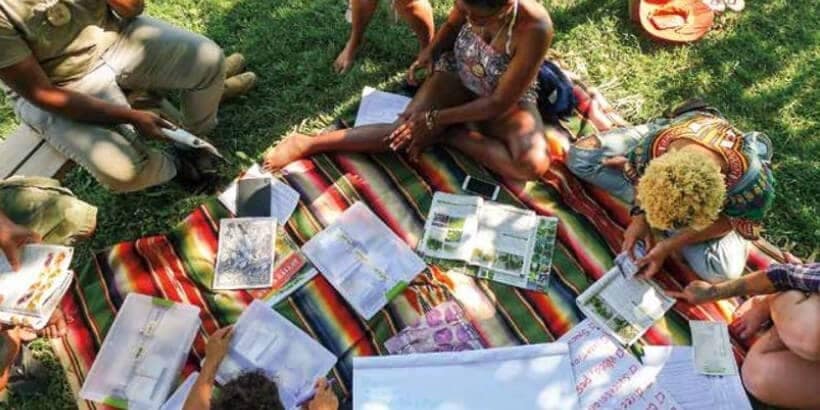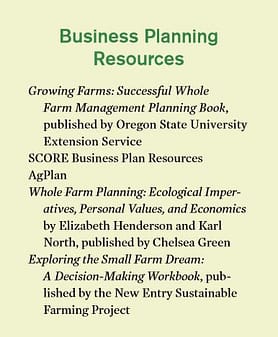Lessons in Resilience: How to Plan a Successful Farm Business

Humans specialize in resilience. We have the capability to create wondrous things out of seemingly nothing and continuously reinvent ourselves. However, when the world is against us, it may seem impossible to accomplish our goals.
Leah Penniman, co-founder of Soul Fire Farm, wanted nothing more than to be able to provide nourishing food for her family, and yet, due to significant barriers to entry, she was unable to. But being the resilient human that she is, Leah worked to reduce those barriers not only for herself but her community as well and was able to build a business that would address these issues and create a long-term solution for the future.
The following excerpt is from Farming While Black by Leah Penniman. It has been adapted for the web.
Between my partner and me, we had two college degrees and 15 years of farming experience, and yet were unable to provide our newborn and toddler access to nourishing food. There were no farmers markets, co-ops, or grocery stores on Grand Street in Albany’s South End, just a liquor store, bodega, and McDonald’s. The community garden plots were all taken for the season, and we did not find neighbors willing to share their paltry growing spaces with our family. Temporarily unemployed, I was accepted into the Women Infants and Children (WIC) nutrition assistance program, which rationed conventional cereal, milk, and eggs when I was willing to endure the glares and, once, the spit of impatient customers in line behind me.
As I child, I experienced hunger and food scarcity, growing up in a trailer in rural Massachusetts with a single parent holding down multiple jobs in order to provide for three children. However, I imagined that those days of exiguity were past and expected that my own children would enjoy abundant, life-giving food.
Eventually we found a community-supported agriculture (CSA) program that offered a pickup point 2 miles uptown. The price of the share became our second largest expense after the rent. Since we were carless, collecting our share involved a weekly walk with one child strapped to my back and the other in the stroller. On the return trip, the stroller-bound child protested mildly as she balanced the heavy vegetables in her lap.
As we built relationships with our Albany neighbors, we learned that our struggles to access food were echoed throughout the community, with the most significant barriers being cost and transportation.
Soul Fire Farm was born in response to the South End community’s yearning for life-giving food and our family’s passion for connecting land stewardship and social justice. We believed that to free ourselves collectively, we must feed ourselves. Rooted in the principle of Ujamaa, cooperative economics, we decided on a subscription-based farm-share model that would reduce the access barriers of transportation and cost, while providing the farm with guaranteed income.
In 2011, the first year of our Ujamaa Farm Share CSA, fewer than 20 families signed up, almost all of them our former neighbors from the block. I did most of the growing in the evenings and delivered vegetables and eggs on Sundays, working around my full-time public school science teaching job. We accepted SNAP/EBT (formerly food stamps) and charged a sliding scale based on self-reported income. To address the transportation barrier, we brought bushel boxes stuffed full with a rainbow of mineral-rich bounty right to people’s doorsteps. Each year we grew the program, expanding beyond the South End to other neighborhoods impacted by food apartheid, including West Hill, Arbor Hill, and South and North Troy. My partner, Jonah, paused his natural building business to work on the farm full-time, and eventually, we welcomed apprentices, then staff. We currently have 80 to 100 families in the program who affectionately term it “Netflix for vegetables.”
Just as it takes a village to raise a child, so does it take a village to steward a farm. Soul Fire Farm was, in many ways, the third biological child of Jonah and me. This beloved farm child needs at least as many resources, time, tenderness, 24/7 care, and deep commitment as our two human children. However, it would be deeply dangerous and counter mission to keep this child trapped in our nuclear family. We grew our village slowly, first with another family of close friends who built a bohío (Puerto Rican roundhouse) and lived with us part-time. Then we welcomed apprentices and interns to live in our home from anywhere from a few months to a few years. We incorporated and built a board of 15 directors for shared accountability and ownership. We have a committed and brilliant staff of 3 to 10 people depending on the season. The farm and the CSA are now managed by the land-loving power trio of Larisa, Damaris, and Lytisha; while Amani and I facilitate the programs; and Jonah keeps the human habitat in order. Over time the Soul Fire Farm village has grown into concentric circles of hundreds of committed individuals to whom the project is accountable.
To help others, we’ve provided a template that we used to guide our mission-driven business plan.
Writing Your Farm Business Plan
Nikki Giovanni reminds us that “Style has a profound meaning to Black Americans. If we can’t drive, we will invent walks and the world will envy the dexterity of our feet. If we can’t have ham, we will boil chitterlings; if we are given rotten peaches, we will make cobblers; if given scraps, we will make quilts; take away our drums, and we will clap our hands. We prove the human spirit will prevail. We will take what we have to make what we need. We need confidence in our knowledge of who we are.” We always begin our business planning sessions with a conversation on this prophetic quotation.
As survivors of racial trauma, we often limit our imagination of what is possible. Babalawo Enroue Halfkenny explains that we carry a great fear of confronting the no that might destroy us. So we create a safe box in which to exist, pre-settling for a life that is much smaller than our capacity. Our internalized oppression is so powerful that the oppressor no longer needs to act. The prison of our own skewed sense of inadequacy, of not deserving, of not being enough, is all that is required to keep us in bondage.
The first step in writing a business plan, which is really a plan for the tangible love you want to manifest in the world, is to imagine widely what is possible. We invite you to light a candle, call upon your ancestors, close your eyes, and dream into your biggest visions. The following are specific considerations that we found useful in creating a mission-driven business plan.
Values and Mission
Values are the core beliefs and philosophies that guide your life and change very little over time. Your project needs to be firmly rooted in your central values, whether those be family, environmental stewardship, thrift, or hard work. To get in touch with your values, a helpful exercise is to draft your own obituary. While this may seem morbid, the reality is that all of us will transition from this life, and taking time to reflect on how you want to be remembered can put the big picture in clear focus. From your list of values, you can draft a mission statement. A mission statement describes the specific purpose of your business and its guiding principles.
Way of Life and Personal Needs
Consider aspects of your quality and style of life that are important to you. To what extent do you want your personal life and work life to be separate? Do you prefer to work alone or have a lot of interaction? How much time do you need for rest and for being with family and friends? Do you enjoy marketing and interacting with customers? What are your favorite tasks on the farm? Are you comfortable with uncertainty and risk? What does financial security mean to you? What other time commitments are you juggling and how does this farm fit into those responsibilities?
Existing Resources
What assets do you currently have that can be leveraged toward the manifestation of your project? Consider not only your financial resources, but your existing knowledge and prior experiences. Who in your social networks might contribute skills or labor to your vision? Do you currently have access to land or infrastructure? Is there a ready market for your harvest?
Strategic Goals
What would you like to accomplish within the first three years of your farm project? Strategic goals should be SMART: Specific, Measurable, Accountable to Community, Realistic, and Time-bound. Consider writing goals related to what you will produce, your impact on the ecology of the land, your financial sustainability, and your quality of life.
Income and Expenses
Investigate markets in your area to determine how much income you are likely to generate from your products. At Soul Fire Farm we convened a group of our neighbors to gauge interest in vegetable delivery and determine a reasonable price point. Next, calculate your start-up and operating expenses. Start-up expenses include land, equipment, tools, and infrastructure. Ongoing operating expenses include seeds, compost, mulch, utilities, supplies, transportation, veterinary expenses, feed, insurance, certifications, labor, and maintenance. A sample operations budget for Soul Fire Farm is provided in table 2.2, which demonstrates how a farmer can make a reasonable living intensively cultivating less than 2 acres (0.8 ha) of land.
Production
Will you produce annuals, perennials, livestock, and/or value-added products, and what varieties of each? Annual crops include vegetables, grains, herbs, and flowers and require intensive labor during the prime growing season. Perennial crops include nuts, fruits, hops, and grasses and take several years to earn a return on investment. Livestock systems include raising animals for meat, dairy, eggs, or honey, and involve daily chores for the entire year. Consider your personal needs and existing resources in deciding what to produce. Think about whether you will use organic, conventional, or other production techniques and what the certification requirements are for your selected method. Consider what culinary historian Leni Sorensen terms “home provisioning,” the act of growing and preserving food for the nourishment of your family as a priority over market sales.
Recommended Reads
Recent Articles
Aside from the sheer pleasure of telling your friends, straight-faced, that you maintain your garden using something called a “chicken tractor,” there are a slew of other benefits to working the land with a few of your animal friends. Getting rid of pests without chemicals, for one; letting them do the work of weeding and…
Read MoreIf the idea of running a vegetable farm sounds daunting, you’re not alone. What can you do to simplify techniques and reduce expenses? Where do you even begin?
Read MoreWhen you’re walking around the grocery store looking at the vegetables, it’s probably hard to imagine that a century ago there was twice the amount of options.
Read MoreIf you love tomatoes, you probably already know just how many varieties of these summertime staples there are. But do you know what makes each one unique?
Read MoreAdding the long game of trees to your system results in a deeper and more reliable, resilient and profound presence to your annual vegetable production.
Read More










